VATICAN CITY (VATICAN CITY)
America [New York NY]
March 14, 2021
By Colleen Dulle
Eight years ago today, Pope Francis emerged on the balcony of St. Peter’s Square for the first time, clad not in the red ermine cape and new red loafers prepared for the next pope, but in a simple white cassock and his old black orthopedic shoes.
His simple apparel set the tone for what would become a whirlwind papacy including 52 papal trips, six major documents, three synods and thousands of speeches and homilies aimed at shifting the church toward simplicity, collegiality and care for the poor and outcast.
While much ink has been spilled by Vatican watchers interpreting how the pope’s writings and structural changes will shape the church for years to come, Pope Francis’ gestures may do even more to define his legacy.
Long after “Amoris Laetitia” and “Laudato Si’” have faded into history, people will remember the images of this South American pope warmly embracing a man covered in tumors, falling to the ground to kiss the feet of formerly warring African leaders or praying alone in the rain in St. Peter’s Square at the height of the coronavirus pandemic.
This is a pope who lives the phrase often attributed to his namesake, St. Francis of Assisi: “Preach the Gospel at all times. When necessary, use words.”
In honor of eight years of Pope Francis, here are the top eight images from his pontificate.
1. Pope Francis greets the world for the first time as pope, March 13, 2013
Going into the 2013 conclave, few people considered Cardinal Jorge Bergoglio a frontrunner—least of the cardinal-archbishop of Buenos Aires himself. As America’s Vatican correspondent Gerard O’Connell details in his book The Election of Pope Francis: An Inside Account of the Conclave that Changed History (Orbis, 2019), when Francis emerged on the balcony of St. Peter’s Basilica for the first time as pope, he “just stood there in silence, immobile. He seemed stunned by the sea of humanity that stretched out in the darkness before him across the square, right down the Via della Conciliazione reaching toward Castel Sant’Angelo.”
He greeted the crowds as his “brothers and sisters” and said: “You know that it was the duty of the conclave to give Rome a Bishop. It seems that my brother Cardinals have gone to the ends of the earth to get one, but here we are!” Before giving his blessing, he asked for the crowd to pause and pray for him for a moment first. A hush descended.
Mr. O’Connell writes that there was something new in the Roman air that night: an anticipation that the first non-European pope in 1,200 years, the first Jesuit pope and the first to take the name of St. Francis might, as he told the cardinals in their pre-conclave meeting, open the windows of a dusty church to let the Holy Spirit blow in.
2. Washing the feet of prisoners, women and Muslims at Holy Thursday, March 28, 2013
Just after his election, the new pope caught the world’s attention when he held a small Holy Thursday liturgy at a youth detention center. Breaking with tradition, the pope washed the feet of 12 young inmates including, for the first time, two girls: one Christian and one Muslim. Three years later, he would change the text of the Roman Missal to officially include women in the foot-washing rite, a move that faced resistance within the Vatican.
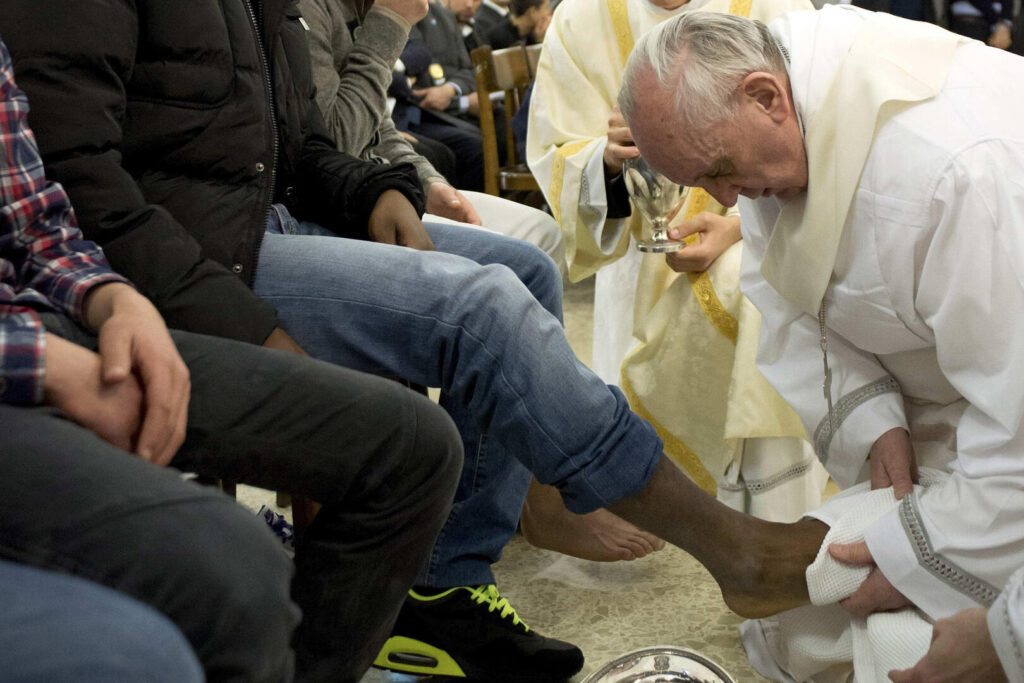
Every year since, the pope has washed the feet of women, minorities and those on the margins of society, like the elderly, at his Holy Thursday liturgies.
3. Pope Francis embraces a man with a severe skin condition, Nov. 6, 2013
Vinicio Riva was used to people being afraid of him. He had learned to stifle his anger when people harassed him for his skin condition: His face and body are covered in severe tumors that often bleed through his shirt, his aunt told C. So he was shocked when Pope Francis approached him without hesitation at a public audience in November 2013, embracing him and letting him bury his head in the pope’s chest.
“When he came close to us, I thought he would give me his hand [to kiss],” Mr. Riva’s aunt, Caterina Lotto, told CNN. “Instead he went straight to Vinicio and embraced him tightly. I thought he wouldn’t give him back to me, he held him so tightly. We didn’t speak. We said nothing, but he looked at me as if he was digging deep inside, a beautiful look that I would never have expected.”
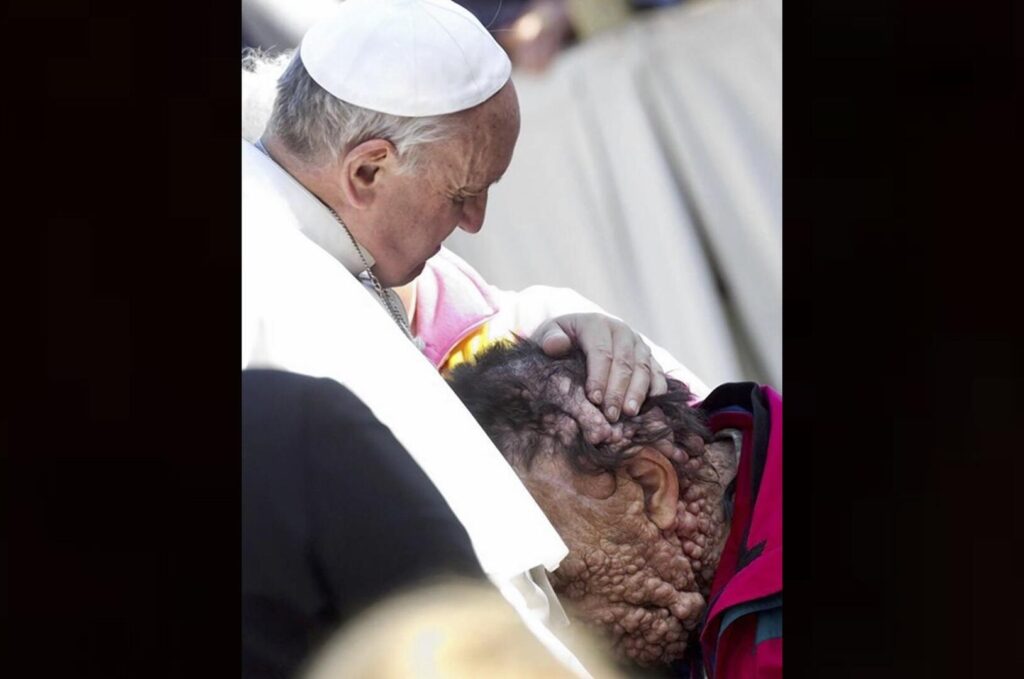
The image went viral, part of the “Francis effect” that touched the hearts of the world early in the Francis papacy.
4. Ecumenical Patriarch Bartholomew kisses Pope Francis’ head, Nov. 29, 2014
During his papal trip to Istanbul, Pope Francis asked Ecumenical Patriarch Bartholomew, the spiritual leader of Eastern Orthodox Christians, to bless him and “the church of Rome.” When he bowed for the blessing, the patriarch kissed him gently on the head.
The two men have a warm relationship, often kissing one another on the cheek and embracing when they meet. Achieving unity between the Eastern and Western churches, which have been in schism since the Middle Ages, is one of Pope Francis’ major goals.
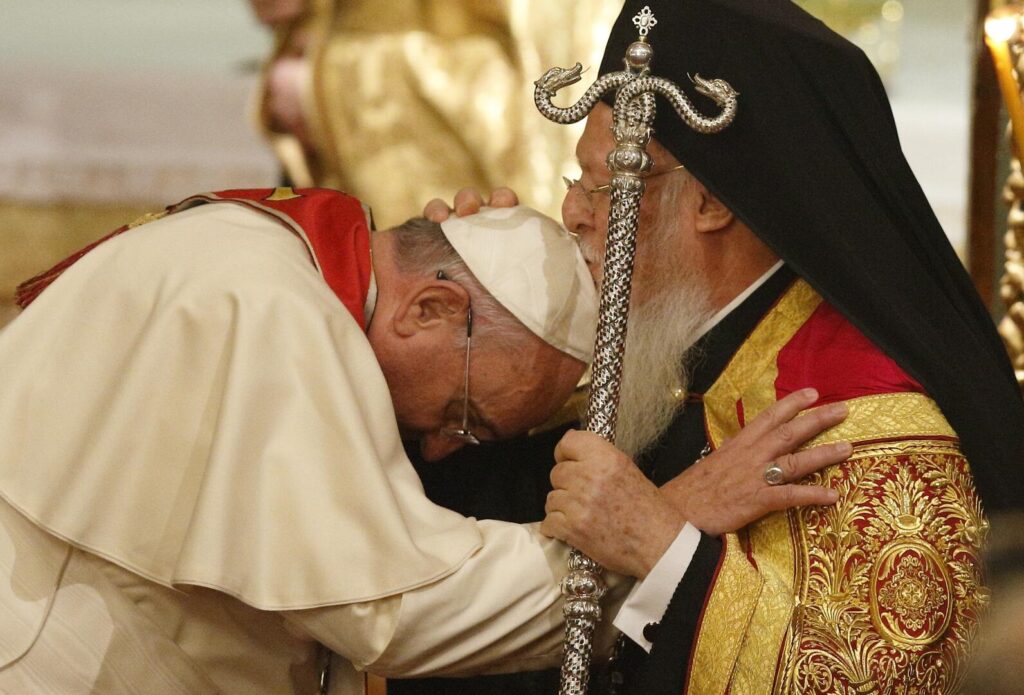
5. A beam of light hits Pope Francis’ cross on his return flight from Dublin, Aug. 26, 2018
Pope Francis’ trip to Ireland was expected to be his most challenging yet. The thrill of his first years as pope had worn off, and the American church was embroiled in what has since been called its “summer of shame”: the second wave of sexual abuse revelations brought about by the Pennsylvania Grand Jury report, which recounted in detail 70 years of abuse allegations, and revelations that the influential Cardinal Theodore McCarrick had abused minors and seminarians.
The Irish church, once culturally dominant, had lost thousands of adherents after sexual abuse revelations began there in the 1990s.
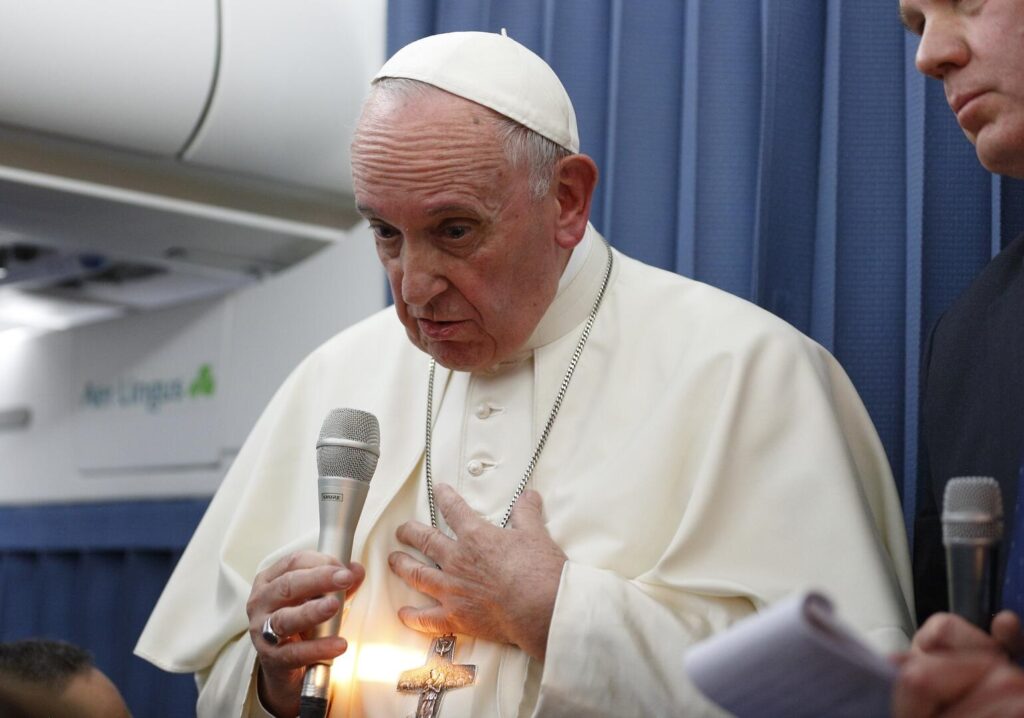
During the night of the pope’s two-day trip, former papal ambassador to the United States Archbishop Carlo Maria Viganò released a bombshell letter alleging that members of the Roman hierarchy had turned a blind eye to former Cardinal McCarrick’s abuse. The letter called on Pope Francis to resign, in a move which Vatican reporter Christopher Lamb called a “half-cocked coup against his papacy.” Viganò’s claims against the pope were debunked by the press and, after more than two years, the Vatican.
In the moment, though, Pope Francis declined to comment on the letter. When CBS News reporter Anna Matranga asked Pope Francis about during a press conference on his return flight to Rome from Dublin, the pope said, “I read the statement this morning and, sincerely, I must say this to you and anyone interested: Read that statement attentively and make your own judgment…. I think the statement speaks for itself, and you have a sufficient journalistic ability to make a conclusion.” As he gave the answer, a ray of light settled on the pope’s cross and fisherman’s ring.
6. Kissing the feet of formerly warring South Sudanese leaders, April 11, 2019
During an unusual Anglican- and Catholic-sponsored retreat for formerly warring South Sudanese leaders, Pope Francis shocked the nation’s president and four of its five vice presidents by spontaneously bowing to kiss their feet as he begged them to work together for peace. The vice presidents represent different factions that had formerly been at war but had agreed to share power in an effort to make peace in the country.
As South Sudanese Bishop Eduardo Hiiboro Kussala told America, the pope’s gesture was “seen as nothing less than a miracle, nothing less than God’s intervention,” by members of a culture that prizes deference to one’s elders.
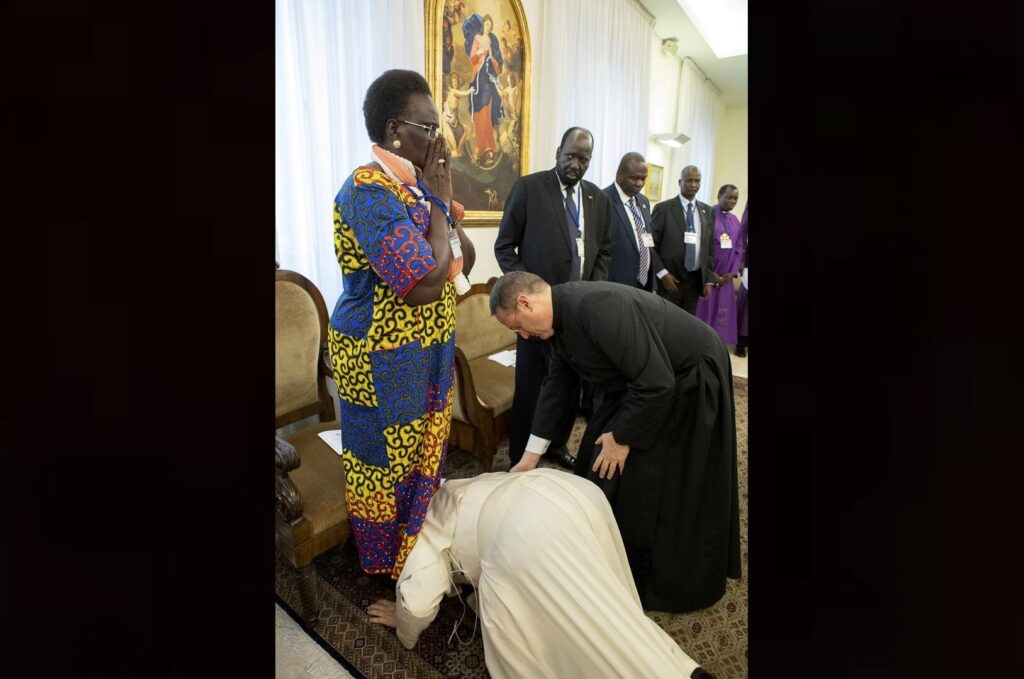
7. Pope Francis prays in St. Peter’s Square for an end to the coronavirus pandemic, March 27, 2020
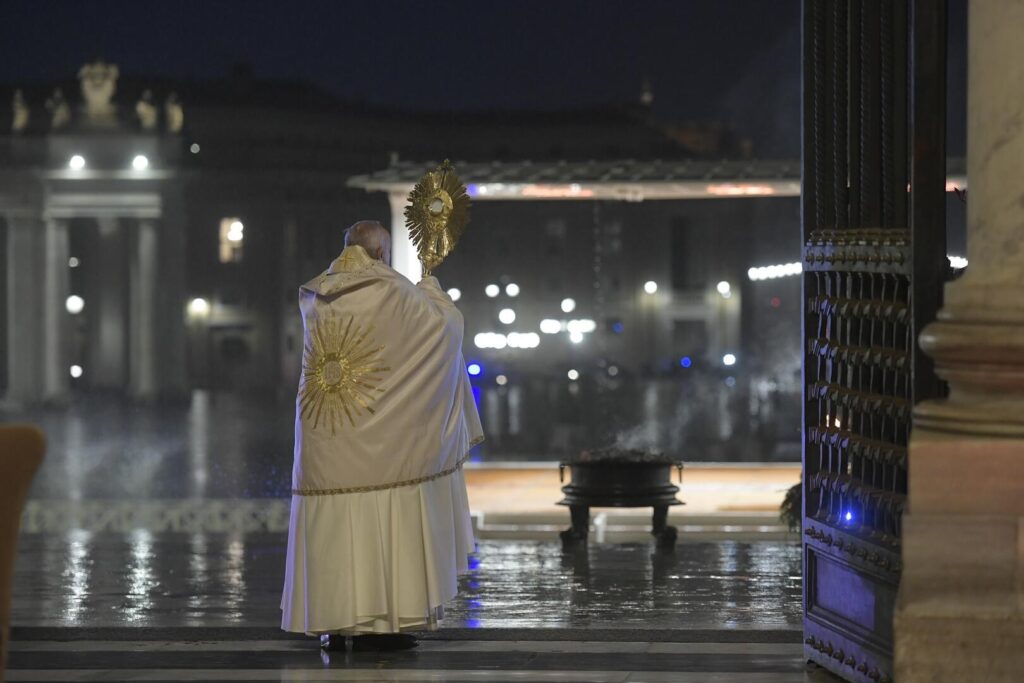
At the height of Italy’s first wave of the coronavirus pandemic, Pope Francis gave an extraordinary “urbi et orbi” (“to the city and the world”) blessing usually reserved for Easter, Christmas and the election of a new pope.
The stark service, held in an empty, rain-soaked St. Peter’s Square, was broadcast to millions of people around the world who were isolated for fear of the pandemic. Reflecting on the Gospel story of the disciples weathering a storm while Jesus is asleep in their boat, he said, “We have realized that we are on the same boat, all of us fragile and disoriented, but at the same time important and needed, all of us called to row together, each of us in need of comforting the other.”
After the reflection, the pope carried a monstrance from St. Peter’s Basilica into the square, hoisting it above his head with great effort, buffeted by the wind and rain, as the church bells and ambulance sirens echoed through Rome’s empty streets.
8. Meeting Grand Ayatollah Ali Al-Sistani, March 6, 2021
Pope Francis declared in the first month of his pontificate that he hoped to build stronger relationships between Christians and Muslims, a commitment he has followed up on by visiting several Muslim-majority countries and signing a milestone document with Sunni Grand Imam Ahmad al-Tayyeb, which would serve as the inspiration for the pope’s recent encyclical, “Fratelli Tutti.”
This year, he has focused on making inroads with Shia Muslims, meeting with the revered cleric Ayatollah Ali al-Sistani. The ayatollah has not received guests publicly or been photographed in a decade, but he met with Pope Francis in his home last week, greeting him warmly and speaking with him for almost an hour. The meeting, experts said, sent a message of peace across the Muslim world.
In advance of the meeting, street art of the pope and the ayatollah appeared on walls around Najaf, the Islamic holy city where the two leaders met. One image called the encounter a meeting of the church bells and the minarets, the towers from which Muslims are called to prayer. A Shia poet wrote that the baba of Christianity and the baba of Islam would embrace, playing on the similarities between the words for “papa” and “pope” in many languages.
